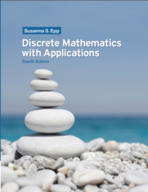

Discrete Mathematics with Applications 4
Write in words how to read each of the following out loud. a. \(\left\^ \mid 0\) b. \(\ \mid x \leq 0 \text < or >x \geq 1\>\) c. \(\ \mid n \text < is a factor of >6\>\) d. \(\left\^ \mid n \text < is a factor
Discrete Mathematics with Applications 4
Rewrite the following statements less formally, without using variables. Determine, as best as you can, whether the statements are true or false. a. There are real numbers \(u\) and \(v\) with the property that \(u+v
Discrete Mathematics with Applications 4
For all objects J, if J is a square then J has four sides. a. All squares ________. b. Every square ________. c. If an object is a square, then it _________. d. If J , then J _______. e. For all squares J , ________.
Discrete Mathematics with Applications 4
Let A = and B = . Define a function F: \(A \rightarrow B\) by the following arrow diagram: a. Write the domain and co-domain of F. b. Find F(1), F(0), and F(1).
Discrete Mathematics with Applications 4
For each integer n, let \(T_=\left\\right\>\). How many elements are in each of \(T_2,\ T_,\ T_1\) and \(T_\)? Justify your answers.
Discrete Mathematics with Applications 4
Given any two real numbers, there is a real number in between. a. Given any two real numbers a and b, there is a real number c such that c is _____. b. For any two ______, _______ such that a < c < b.
Discrete Mathematics with Applications 4
Problem 24E The lights in a classroom are controlled by two switches: one at the back and one at the front of the room. Moving either switch to the opposite position turns the lights off if they are on and on if they are off. Assume the lights have been installed so that when both switches are in t
Discrete Mathematics with Applications 4
In 47-50 (a) use the logical equivalences \(p \rightarrow q \equiv \sim p \vee q\) and \(p \leftrightarrow q \equiv(\sim p \vee q) \wedge(\sim q \vee p)\) to rewrite the given statement forms without using the symbol \(\rightarrow\) or \(\leftrightarrow\), and (b) use the logical equivalence \(p
Discrete Mathematics with Applications 4
Define a relation P from \(\mathbf^\) to R as follows: For all real numbers x and y with x > 0, \((x, y) \in P \) means that \(x=y^\). Is P a function? Explain. Text Tr
Discrete Mathematics with Applications 4
Indicate which of the following sentences are statements. a. 1,024 is the smallest four-digit number that is a perfect square. b. She is a mathematics major. c. \(128=2^\) d. \(x=2^\) Text Transcription: 128=2^6 x=2
Discrete Mathematics with Applications 4
Problem 38E True or false? All occurrences of the letter u in Discrete Mathematics are lowercase. Justify your answer.
Discrete Mathematics with Applications 4
Use Theorem 2.1.1 to verify the logical equivalences in 50-54. Supply a reason for each step. \(\sim(p \vee \sim q) \vee(\sim p \wedge \sim q) \equiv \sim p\) Text Transcription: sim(p vee sim q) vee(sim p wedge sim
Discrete Mathematics with Applications 4
Find the truth set of each predicate. a. predicate: 6/d is an integer, domain: Z b. predicate: 6/d is an integer, domain: \(\mathbf^\) c. predicate: \(1 \leq x^ \leq 4\), domain: R d. predicate: \(1 \leq x^ \leq 4\), domain: Z
Discrete Mathematics with Applications 4
Problem 31E a. Find an inverse for 210 modulo 13. b. Find a positive inverse for 210 modulo 13. c. Find a positive solution for the congruence 210x ? 8 (mod 13).
Discrete Mathematics with Applications 4
Let M be a matrix with m rows and n columns, and suppose that the entries of M are stored in a computers memory in row major form (see exercise 47) in locations N, N + 1, \(N+2, \ldots, N+m n-1\). Find formulas in k for r and s so that \(a_\) is stored in location N + k.
Discrete Mathematics with Applications 4
Use the set-roster notation to indicate the elements in each of the following sets. a. \(S=\left\ \mid n=(-1)^\right.\), for some integer k>. b. \(T=\left\ \mid m=1+(-1)^\right.\), for some integer i>. c. \(U=\ \mid 2 \leq r \leq-2\
Discrete Mathematics with Applications 4
In the graph below, determine whether the following walks are trails, paths, closed walks, circuits, simple circuits, or just walks. a. \(v_ e_ v_ e_ v_ e_ v_ e_ v_ e_ v_ e_ v_\) b. \(v_ v_ v_ v_ v_\) c. \(v_ v_ v_ v_ v_
Discrete Mathematics with Applications 4
Let A = and B = and define relations R, S, and T from A to B as follows: For all \((x, y) \in A \times B\), \((x, y) \in R\) means that \(x \geq y\). \((x, y) \in S\)
Discrete Mathematics with Applications 4
Use Theorem 2.1.1 to verify the logical equivalences in 50-54. Supply a reason for each step. \((p \wedge(\sim(\sim p \vee q))) \vee(p \wedge q) \equiv p\) Text Transcription: (p wedge(sim(sim p vee q))) vee(p wedge
Discrete Mathematics with Applications 4
The numbers in 17 are all rational. Write each number as a ratio of two integers. 52.4672167216721 . . .